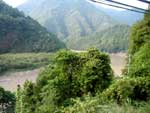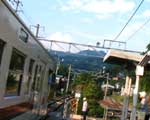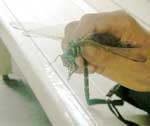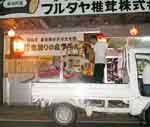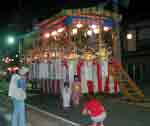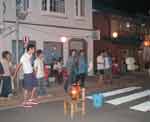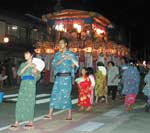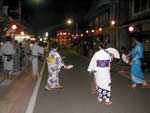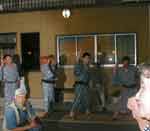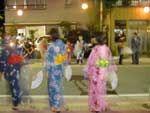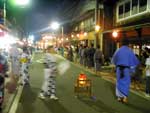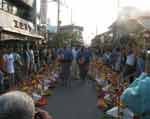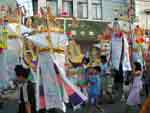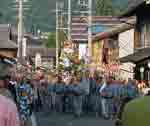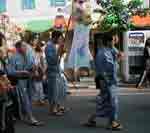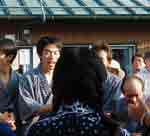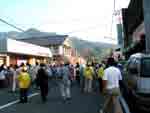Reporters without a car
And now, today is August 16.
Today, we will participate in the biggest highlight (Niino Bon Dancing) during this tour.
However, it was a challenge to reach to Niino.
If you go by car, it takes only a few hours from Gujo Hachiman by going over the mountain. But the fact that “both of us don’t have a car”, became a rather big handicap.
The only way to get there is: Once we return to Minoh Ota on Nagaragawa Railway, and go through Gifu, Nagoya, and Toyohashi, and then, go north along the Tenryu River on the famous local line “Iida Railway”.
Ishimitsu came to realize the naivety of Yanagita that believed “We can get there as long as it is connected by the rail line.” The timetable that was composed after drawing fully upon the strength of train guide was;
“Leave Gujo Hachiman on AM 8:30 and get to Niino on PM 6:00.”
It took a whole day literally, and it was quite a trip on the local line.
And the bus services to Niino ends at 5 PM while there are two hours of waiting time at the way station of Iida Line. Therefore, we can’t reach Niino before the day is over if we fail any transfer of transportation.
It would be a very tough schedule for the two of us, who had 2 consecutive days of Tetsuya Dancing (All night dancing).
We lost no time in having our breakfast and visited the town of Gujo once again.
It is silent around Sougi-sui in the morning. We returned the yukata for dancing which we wore last night to Ishiyama Kimono Shop.
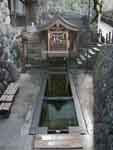
It was a busy morning, but we’d like to see the “Sougi-sui (brand-name spring water)” as far as we came to Gujo. There were few people around the Sougi-sui in the morning, and the cool water appeared breezy.
We returned to Gujo Hachiman Station and got on an inbound train of Nagaragawa Railroad. Of course we went into sleep as soon as we got on the train and kept sleeping during the ride.
To the valley of traditional arts!
We got off the train at Toyohashi Station and headed to the plat home of “Iida Line”.
The train was unoccupied and we got a box seat without any difficulty. It became a good atmosphere when we took train lunch and some cans of beer aboard. It seems that we can enjoy a trip on the local line. The train that departed Toyohashi Station went up north along the Toyo River and headed straight to Tenryu River.
“The valley of traditional arts”
The whole district along the Tenryu River which we are heading to is sometimes called “The valley of traditional arts”.
The place is called “San-en-shin (Mikawa, Tohtoumi, Shinano) region”, and various traditional arts and culture remain. It is sometimes called the drift of folk arts.
We moved from Nagara River to Tenryu River. The traditional culture area of the two different river systems is also different. What kind of amazing Bon Dancing is waiting for us at our destination? We started anticipating as we drank beer.
A profound history of Nagashino
Today, the place is a quiet farm village, but this is where the “Battle of Nagashino” took place. It was a war between Katsuyori Takeda vs. the coalition of Nobunaga Oda and Ieyasu Tokugawa, and it greatly changed the history of Japan. Therefore, a lot of folk arts and oral traditions related to this war are handed down in this place. There is “The Nagashino Castle Museum” run by Houraiji Town near the station. We had enough time and we couldn’t miss it. It was ten minutes walk, but we really felt the strong afternoon sunlight. Inside the museum was literally an enormous collection of historical data of the “war”. The air stagnated heavily, and the armors and weapons that were set out made the climate even more stifling.
What was shocking was the graphic of “Sune-emon Torii” crucified, the hero of the preceding fight of the War of Nagashino. Sune-emon succeeded in making contact with the Tokugawas by breaking out the encirclement of Nagashino Castle by the Takeda army, but unfortunately, he was captured by the Takeda side on his way back. He was crucified by the angry Takedas for he deceived the Takedas and he informed the partisans that the reinforcements will come. The picture painting him with violent colors or in other words vivid colors carries down the fact that the war at that time was very gruesome and thereby made people think of the necessity to repose the soul of the people who died at war.
The Tenryu River: The marvelous nature
We returned to Hon-Nagashino Station again, and made connections of the local trains. The laid-back time passed by. The Iida Line weaves it’s way through the mountains. In the course of time, a scenery came into view from the window in our left side.
It’s Tenryu River.
The train passed places like Mizukubo and Sakuma which are famous for folk arts, and it was already 4:00 PM when the train finally reached the station called “Nukuta” which is our destination.
We were the only ones who got off the train. We found out it to be a lonely ghost station after the train went away.
We had to wait for another hour until the last bus for Niino came.
We were very tired after a long journey, and both of us sat absentmindedly in the waiting room.
Just at that moment, a big insect suddenly appeared into our sight near the entrance of the station.
It hovered the place for a while and it went in in a flank speed. It hit the glass over our heads, and fell on the floor after a faint.
We were surprised and took a look at it. We found out it to be a giant dragonfly that has a wingspan of 20cm.
Ishimitsu explained that “Giants dragonflys fly so fast that even if you could catch them with a ring net, its wings become tattered.”
Ishimitsu’s dream was to get an giant dragonfly alive, but it came true unexpectedly without apparent difficulty. We took a commemorative photo and let it go.
If you go out of the waiting room and walk for a while, the Tenryu River spreads out just in front of you.
If we look around from over the bridge, countless dragonflys fly over the surface of the river in the light of the early-evening.
That’s like the nature of Tenryu River. It’s splendid.
The bus weaves its way though the mountains in nightfall
When the sun almost went down, the last bus for Niino finally arrived.
Of course, we are the only passengers.
After the bus left Nukuta Station and went across the Tenryu River, it climbed the sloping road endlessly. The beautiful mountain range in sunset could be seen from the bus window. Paper lanterns were hang out in some settlements along the way. Probably, Bon Dancing of Okuri Bon (Bon event to send the ancestor’s spirits off) is going to be held around this area.The mountain path meanders in though the deep moutains. It gains its altitude little by little going past the dark forests and deep mountain streams.
The mountain path meanders in though the deep moutains. It gains its altitude little by little going past the dark forests and deep mountain streams.
Niino yoi toko Sengokudaira
Yome ni yaritaya moraitaya
Niino is a good place where the land is rich
Would like to marry off and also take in marriage
(From the Niino Bon Dancing song)
The bus kept running until it entered a street and stopped at its halfway.
We finally arrived in the town of “Niino” in the twilight gloom.
We were very impressed to “Okuribi (Fire to send the spirits of the ancestors)”
We got off the bus.
When we looked at the street carefully, something like a small branch was burning on the street in front of each houses.
“It’s Okuribi!”
It was a heartwarming scene.
We knew that there was something called “Okuribi”. But this was the first time for Yanagita to see the real thing. This is a folkway that has been lost in many regions, and we got excited to the fact that Niino is a region that carries down a precious folk custom where both Bon Dancing and Okuribi is carried down.
However, Ishimitsu gave a questioning look. He told me later that his family performs Okuribi even now, so it was not especially unusual for him.
Anyway, the scene of Okuribi in a village in the mountain valley in the nightfall impressed us feelingly.
The both of us were very tired.
We wished if we could stay in a hotel but we were “homeless” that day. There are few hotels in Niino, so the reservations were full, and we could not reserve one single room after all. Today, we are really going to sit up all night long. The only recourse is the advance information from the town office that “There is a temporary rest station where you can catnap.” As we walked along the street, it appeared that the first floor of the private residence along the street was open to public. We were a little bit relieved to this. We settled in a buffet in town and decided to consider about the strategy of news gathering of today’s dance while we had dinner. The premise was already fairly crowded with viewers and local people. We had our nutrition support with the institution “Gohei mochi” set menu and beer.In the seat next to us, a rather old lady was having dinner alone. She said that she came here to see this Bon Dancig from a very far place. As was expected, here we found another fan of Bon Dancing.
“Kiriko Lanterns” gather together
8:00PM
We finished dinner, took a breather, and went outdoors. The town was pitch-dark.
It seemed that the preparation of Bon Dancing has begun to start around the dancing scaffold in the center of the street. Suddenly, a pickup truck stopped in front of the office of Dance Preservation Association as we took our stand in front of the office and waited for the dance to start. When we looked into it as we held a digital camera, we found an amazing “Kiriko Lantern”! In Niino, people gather the lanterns that were used in Niibon or Shimbotoke (The spirits of the dead who died after the Obon of the previous year and until the Obon of the current year, in this case the family of the dead), and decorate them around the dancing scaffold on this day.
Later on, the Kiriko Lanterns arrived one by one, and ultimately, a total of 23 (I heard so) lanterns was gathered. We know from this that in Niino, 23 people passed away in this year.
In the Bon Dancing of Oku Minoh Region, Kiriko Lanterns were something of an abstraction. The Kiriko Lanterns in this place still have the reality of “death”. In the night of August 15, which is the last day of Obon, Kiriko Lanterns will be decorated around the dancing scaffold, and the local people dance all night long around it. It is literally a Bon Dance you dance with the new spirits (people who died recently). Therefore, we can say that the main character of this dance are the new spirits and their family. In Niino, we can still see the soul of Bon Dancing that perhaps goes back to the Middle Ages but is forgotten in the present days.
We waited for the dance to start as we watched the construction of the dancing scaffold and strolled around. However, people gathered and started a lecture meeting at the “temporary rest station” that we found a while ago. We said in our hearts; “You will allow us to sleep later on, aren’t you?” We got a little bit anxious since the rest station is our only recourse.
The children started the dance
9:00 PM
Bon Dancing started at last.
It’s about time to end if it were Bon Dancing in the urban area.
.
The ones who started dancing were the elementary school and junior high school children in casual wear. And it was by twos and threes. They also held back to dance and the dance was unequal.
Here in Niino, the local community plays the leading role consistently in Bon Dancing, and the mood is very naive. It is a graceful Bon Dancing that is completely indifferent to the hustle and bustle of the tourists
Every dancer wears a fan in the obi (belt) and they spread and use this in the four types of dances. Some people pick the stick of the fan between their fingers and some hold the pivot. There is a variety of holding the fan, and it is interesting. There is an opinion saying that the reason why they use fans in Niino is the influence of Ise Ondo, and there are Bon Dancings that use fans in various places.
In the other hand, many people wear Japanese sandals, and few people wear getas.
A very big characteristic of Niino Bon Dancing is that they lead the chorus by using only the natural voice and they don’t use musical accompanyments and drums. Some singers lead the chorus in unison with the lead singer of a cappella on the scaffold, and the dancers answer to this by returning calls and shouts. It is a style of simple “dialogue”, unchanged since olden times. It seems that they performed in the same way around Gujo region until around the Taisho Era.
We flung ourselves into the “Rest Station”
A few minutes past 10:00 PM
The number of dancers incresed, and the Bon Dancing became full of life.
There are 7 types of dances in total and 6 types among them will be danced repeatedly. I knew the general principles that “A dance starts from the movement of the feet”, and I was confident of learning the dance. However, many of the dances use fans (it is a little bit close to “Mai dance”) and I was focused in the movements of the fans which I was not very used to, so I had a hard time to grasp the techniques of the dances.
The songs of the Niino Bon Dancing was naive and fantastic, but it was tedious and tough for us in that time of the hour.
Since we were tired after “Three consecutive days of Tetsuya Odori (all night dancing)”, we were very sleepy after 11:00 PM.
We took a look at the “Temporary Rest Station” which was located in the first floor of machiya (a house in a traditional street) of the old private house. It seemed that the “lecture meeting” that was held in this location has ended. The blankets were piled up in the corner, and a few people who looked like viewers seemed to have laid out the blankets and fallen asleep. The two of us took the opportunity and entered the house, and flung ourselves using our baggage as a pillow.
We didn’t want to miss the mysterious climax which will take place before dawn. We must not fall fast asleep…
The dance was bright in the night of plateau
I opened my eyes and as I happened to look outdoors, a circle of the dance passed slowly by the front door.
Yanagita couldn’t sleep very well after all because of being tired and excited. There was a lot of time before dawn, but we had a second thought that “It is rare opportunity to learn the dance” and decided to get up. When we slipped out of the Rest Station, the number of the dancers decresed markedly and the circle has become considerably smaller.
As may be expected of a place located in high altitude, the night was chilly although it was midsummer.
Today is the third day of the tour, and we had again, a beautiful full moon. The bright moonlight made a shadow on the old street, and the circle of the dance turns around quietly. It seems that Bon Dancing reached the highlight. The mood of the dance became fantastic.
It seemed that in this time of the hour, the people who remain in the dancing circle are those who love to dance and those who are good at it. It seemed that the choreography was becoming more equal.
We joined the circle, and as we danced losing all awareness of time, we began to get the feel of the dance little by little. Our mind became clear probably because we rested for a while, and we also felt better. Ishimitsu was dancing in the other side of the dancing circle.
Six types of dances were repeatedly danced endlessly in the street in small hours.
The high point in the first hours of morning
The mood began to change after around 5:00 AM at dawn when the light grew a little bit. The small dancing circle began to get bigger and bigger imperceptively.
Small children around the age of elementary school came in to the dancing circle rubbing their drowsy eyes led by their parents.
As the time passed, the dancing circle stretched out rapidly, and at last, a great number of people were dancing in the same circle all the way down the street. The number of people were so many that we couldn’t tell where all these people came from.
Probably, all the people around the region gathered to take part in the climax of Bon that is held once a year.
When it passed around 6:00 AM, there was a movement in the dancing circle.
People who seemed to be the members of the Preservation Association began to gather. As the dancing circle turned around in a straightforward manner, the Kiriko Lanterns which were decorated on the dancing scaffold in the center were brought down one by one. The Kiriko Lanterns were drew up in two lines in the center of the street. A child of the age of elementary school are attending each lantern. It seems that it is the role for the children of the family of Niibon.
The sun rose, and it became brighter.
In the dancing circle, the caretakers of the Preservation Association lined up as if to protect in front and behind the row of the lanterns. Some people held a decoration that looked like the bamboo of the Star Festival. There was also a mountain ascetic in the head of the row.
The parade began to proceed when the children holding the lanterns got to their feet.
“Noto”, the last dance
The parade went through the dancing circle and proceeded the street straight to the perch.
In course of time, the figure became smaller, turned the corner and disappeared from sight. It seems that a ceremony will be held somewhere where it can’t be seen by other people. People holding cameras followed after them.
We wondered a little, but decided to stay at the place, since something might be held at the site.
The dance at the site changed to “Noto” which is the last dance.
“Noto” is a mysterious dance which is allowed to dance once a year only in the final hours of the Bon. It is a Teodori (Hand dance) which doesn’t use the fans, and the gesture that they sometimes punch the air is impressive.
Notowa kikusano hon-motoda
That is true, because Noto is a wonderful land that can be the home for even the plants and trees.
(From the lyrics of “Noto” of Niino Bon Dancing)It is an easygoing dance song which is a little bit plaintive. From this moment, we felt that this is an event only for the local people, and the dance was very atmospheric.
I left the dancing circle and set up the camera. From here, finally we’d like to devote ourselves to the coverage of the mysterious event.
Odori Kami-okuri (Dance to send the gods off)
People are still dancing “Noto” at the dancing site. However, little by little, tension began to fill the place.
It was about 10 minutes after the parade left the site.
Suddenly, “Bang, bang”, the crack of gun blared out around the place. It seemed something like a signal. The dance became more and more enthusiastic.
In the course of time, the parade of lanterns came back from far away. They bang the tegane (handheld gong), making a big sound, and parade the way singing, “Nanmaidambo”, “Nanmaidambo”. This is a phrase that remains the tradition of the Nembutu art of the old Middle Ages.
It was a group that had an eccentric impact, and we haven’t seen this kind of group before.
This is the scene of the end of Obon in Niino.
The parade of lanterns that came back has now become the “Obon” itself. The front of the parade of “Obon” is still “summer” and the back is already “autumn”. Therefore, here you can have a very exceptional experience that is, watch the passing of summer and the coming of autumn literally in front of you.
And as the parade of “Obon” passes in front of themselves, people quit the dance one after another and follow after the parade. In the place where “Obon” has passed and autumn has come, it is not allowed to dance the Bon Dancing until the next year Obon.
The mixture of “Life” and “Death”
Suddenly, 7 to 8 young men and women jumped in to the middle of the road. They started dancing forming a scrum. The song that they are singing in a tremendous speed seemed to be the dance song of “Noto”.
The youngsters blocked the procession of the parade by dancing and starting the circle.
The parade of “Obon” once stopped in front of the scrum, but started moving before long.
The muscular caretakers put their fingers on the scrum of youngsters and tore the youngters from the scrum, one by one. In the beginning, the caretakers made allowance to the youngsters, but soon both of them got serious and the scrum was droven out in the bustle.
Probably, the formerly young men who were in the side which formed the scrum has turned to the side of breaking it in the course of time. The parade of Kiriko Lanterns started the magnificent procession once again, singing, “Nanmaidambo”.
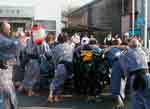
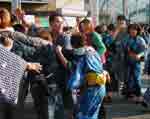

But the youngsters has not given up yet. They got to their feet at once, had a start on the “Obon” parade for about 10 meters, and again formed a scrum and fought back. Those who have already quit dancing moved all together to watch this. And again the parade shoved in to the scrum. By this time, those who are dancing and those who are watching it were excited at its height.
It was definitely an amazing scene.
“Shuukyou no shinsou (The depth of religion)” written by Toshimaro Aman (Chikuma Bunko (Chikuma Publishing)) describe this scene as “The antagonism between life (young men) and death (Kiriko lanterns). However, “the death” wins out after all. Mr. Aman pierces that “This is the image of the transience itself.”
A boy about the age of junior high school entered the scrum given a kick in the back by his father. He was shy at first, but he got caught up in the ripple of excitement in an instant, and he was immersed in dancing. In a few years, he would be the main member of the scrum. And there are people watching the scene from the 2nd floor of the houses. The change and the richness of the expression of the people in this time and place was beyond description.
The resistance of the young people was repeated often and often, but they seemed to give up at last when they reached the edge of the street. The dancers and the spectators followed the parade of “Obon” which proceeded the head and kept marching to the perch.
The time was already 7:00 AM.
Soon it is time of the first bus.
We, who were at the limit in the means of time constraints and physical condition, saw the parade off at the edge of the street, and went back to the street where the silence returned.
“Aki uta (The autumn song)” wraps up the Obon
After this, the parade climbs up a hill at the back of a temple and sets out the Kiriko Lanterns in front of the grave. However, we could not see this scene after all. With everybody watching, a mountain ascetic repeated the mantra, drew a sword suddenly, and cut down the lanterns. After this, they burned the lanterns, shot the gun to send the spirits off, and ended the event of Obon.
What is interesting is that, everyone must not look back after the event ends and must go back in a hurry as if to run away. They say that if you look back, the spirits that you have just sent off will follow you lingeringly. This shows the spiritual culture of the tradition of “Tamaokuri (Sending the spirits off)”
And in the way back, everyone hums the “Aki uta”.
Akiga kitasode shikasae nakuni
Nazeka momijiga irozukanu
but somehow the maple leaves don’t turn red yet
(From the “Aki uta” of Niino Bon Dancing)
Aki uta tells the spirits that the Obon has gone, and also confirm to those alive that the delightful Obon holidays are over. In this sense, it’s ambience is clearly different from that of Bon Dancing Songs.
It is said that these Aki utas remain only in few regions including the outskirts of the Shiiba Village in Miyazaki Prefecture, Kyushu.
The final day was a fair day, and we felt great although we had a lack of sleep.
We climbed up on a hill which was in the back of the station during the time we waited for the train to come. The beautiful clear stream of Tenryu River flowed swiftly far away below our eyes. When we turned our eyes to the river bank in the opposite side, montain villages dotted around the area where it was a little bit higher in altitude. In San-en-shin Region, there are many mountain villages which is isolated by the severe geographical features that was created by the Tenryu River. This fact is one of the reasons why there remains valuable traditional culture in this area.
The stream of Tenryu River that flows in the far distance
I took a look at Tenryu River from the train of Iida Line. When I recalled the 3 days of Tetsuya Dancing (All night dancing), each of them were impressive, and the experience in Niino was a surprise.
There are many things that are unknown in Bon Dancing and Japanese Culture that remains to be discovered. We would like to visit other Bon Dancings next year, hoping to have new surprise and sensation. The Bon Dancing Season of the year 2000 ended for us, the reporters thinking about things like that.
(The end)

